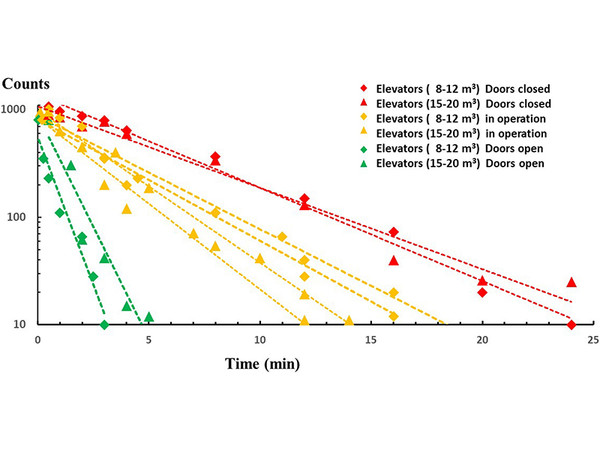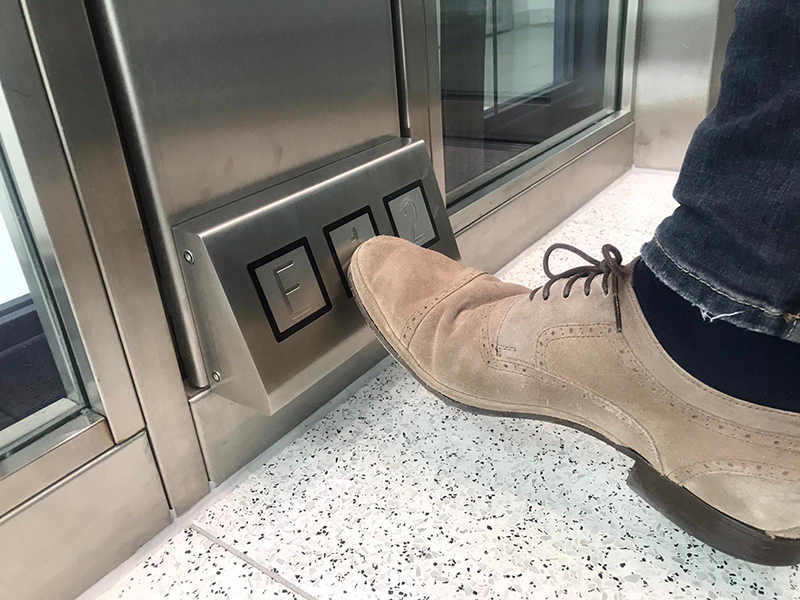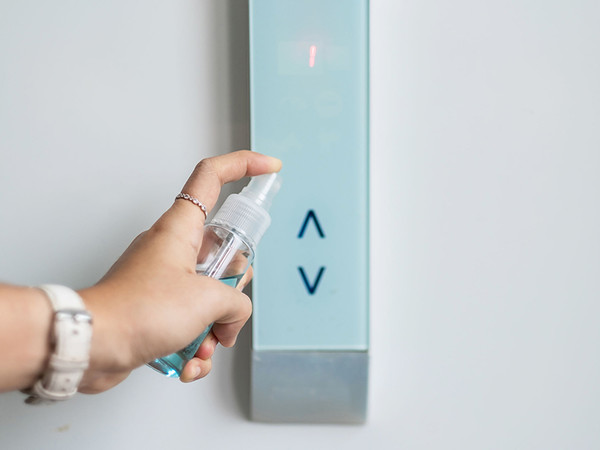Contra: Virus transmission in lifts?
Many companies from the lift sector have invested time, money and energy in systems to protect lift users from Corona infections. But how great is the risk and how can they best be mastered?
LIFTjournal lets two authors with different opinions and assessments express their views.
By Dr Andreas Hunscher
There is almost nowhere that people get as close to each other as in a lift. Nevertheless, there has been almost no political discussion about the risk of infection there to date. So far, there have hardly been any convincing concepts or guidelines here on how to control the pandemic in lifts.
Science was much further ahead in this field of research from the beginning of the pandemic. An article by Songjie Wu et al. from China (2), published in summer 2020, examined potential transmission paths in lifts. The work of Cees van Rijn et al. from the University of Amsterdam (1) from summer of 2020 also examined this subject in detail – and these are just two examples.
Two transmission paths in lifts
 Photo: © Cees van Rijn et al
Photo: © Cees van Rijn et alIn general, there are two transmission paths in lifts: on the one hand, via contact with contaminated surfaces and on the other via aerosols in the air to which viruses can attach.
There was great concern about transmission via surfaces at the beginning of the pandemic. At the time, various studies (e.g. (3)) managed to demonstrate the existence of the Corona virus RNA in part after weeks. However, one should bear in mind that the virus load has a considerable influence on the probability of infection.
As later studies showed – summarised in a publication of the German Federal Institute for Risk Assessment (4) - surface virus loads are very seldom sufficient to infect a healthy person. This of course does not apply to environments with immune-suppressed occupants, such as old age homes or hospitals. For example, Wu et al. noted in the study presented in Wuhan that a considerably increased virus-RNA load was detectable on every second lift button in the hospital examined.
Intuitive operation
Apart from greatly enhanced hygiene – e.g. through more frequent cleaning cycles – voice control or foot buttons could be used for lift calls. Sensor buttons that permit a switching process without touch at a distance of a few centimetres have in practice not proved valuable as hygiene protection, since lift users instinctively still touch the buttons.
Potential infection due to aerosols lingering in the car appear to be more critical, according to recent studies. In this case, it is not just trips in overcrowded cars that are problematic. Solo trips, where the user thinks, "I'm alone, I can take my mask off," are especially risky. This was shown by an Amsterdam study of Cees van Rijn et al:. aerosols do decrease in a logarithmic linear progression, but often still linger several minutes in the car in significant numbers.
Ozone harmful to health
 Photo: © Schmersal Böhnke + Partner
Photo: © Schmersal Böhnke + PartnerThe easiest protective measure is continuously wearing an FFP2 mask. There are now also various air purification systems on the market – they combat viruses with filters or UV radiation.
To avoid harming users’ health, care must be taken that the devices only operate with UV-C radiation above 250 nm – otherwise ozone harmful to health can form (from <180 nm). When designing radiation chambers, complying with the scattered radiation limits specified in DIN 15858 is essential; otherwise, UV radiation emissions can result in considerable health impairments.
The diagram of Cees van Rijn et al. shows a simpler solution: when the doors are open, the number of aerosols very quickly falls by about 90 percent. In general, this simple solution according to EN 81-20 is perfectly permissible. However, the standard also makes reference to the local building law circumstances. Fire protection must above all be complied with – the lift shaft may connect several fire compartments; the doors may serve as fire protection doors.
In this case, this simple solution is not possible – or for example only if the fire alarm system is connected with the lift controller. The operator can clarify this with the local fire protection authorities. Another condition for this is the installation of a UCM circuit, but this has in any case been mandatory for lifts commissioned since 1 January 2012.
More intensive fan operation
 Photo: © jopanuwatd/123RF.com
Photo: © jopanuwatd/123RF.comApart from longer opening of the doors, the authors of the Amsterdam (1) study also regard more intensive fan operation as a solution option. Existing fans can be set to a greatly increased air throughput through simple parameter assignment of the lift controller.
In summary, one can say that achieving a rapid reduction in the infection risk in lift cars is certainly possible. This would involve both the operator, who can strive to achieve a pragmatic solution, based on the local circumstances together with the lift service company. But politics also needs to act; it should devote more attention to the subject and create appropriate incentives.
The author is the managing director and head of the lift division of the Schmersal Group.
Pro: Virus transmission in lifts?
Sources: (1) Cees van Rijn et al: "Reducing aerosol transmission of SARS-CoV-2 in hospital elevators", indoor air, Sept 2020
(2) Songjie Wu et al: "Environmental contamination by SARS-CoV-s in a designated hospital for coronavirus disease 2019", American Journal of Infection control, Aug 2020
(3) Shane Riddel et al, "The effect of temperature on persistence of SARC-CoV-2 on common surface", Virological Journal 07.10.2020,
(4) BfR, Publikation zur Übertragung von SARS-CoV-2 über Schmierinfektion, 09.04.2021


























Write a comment